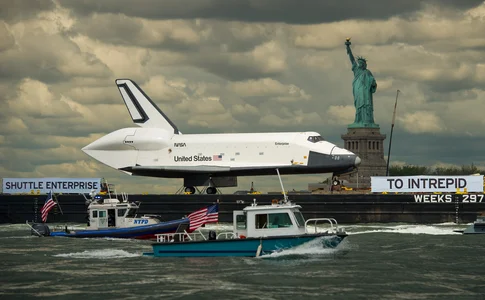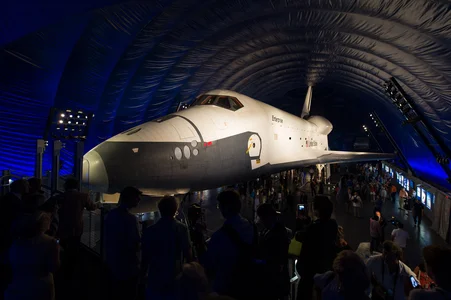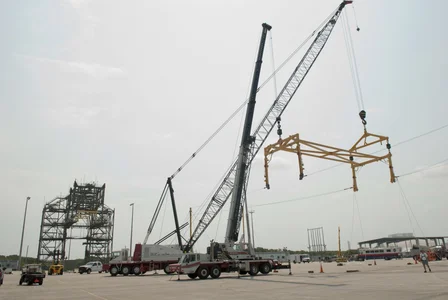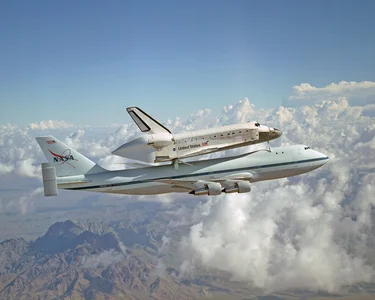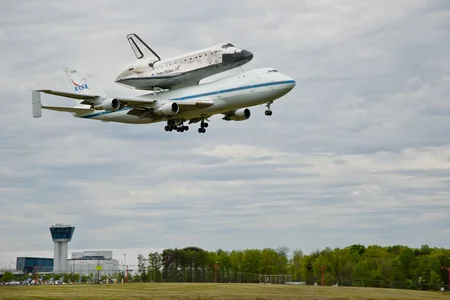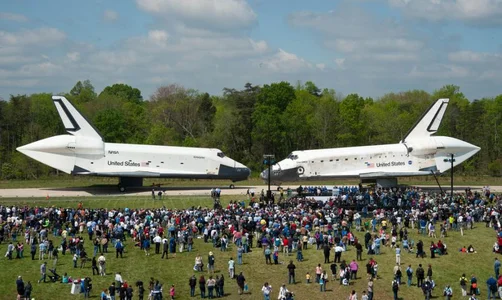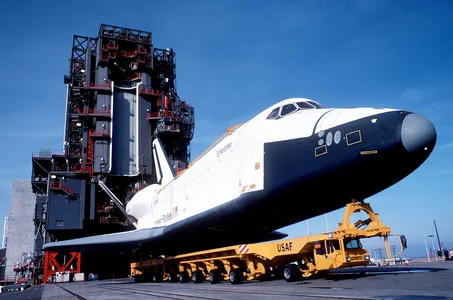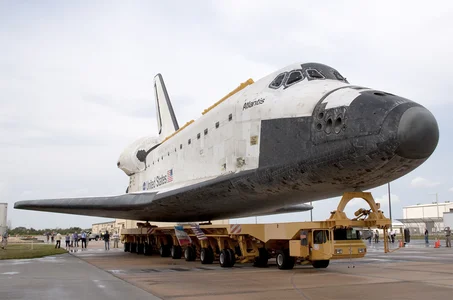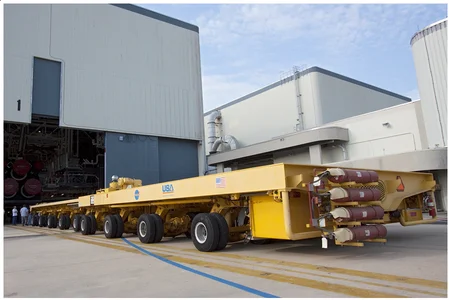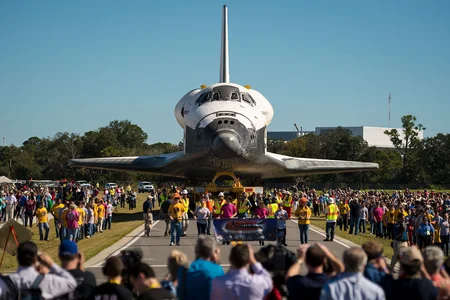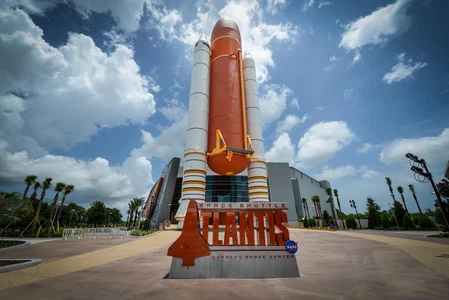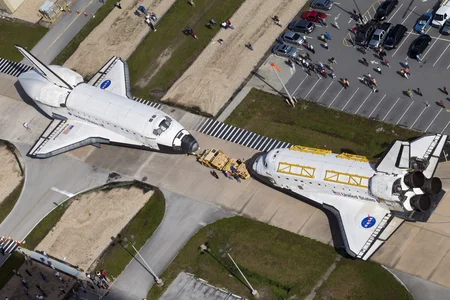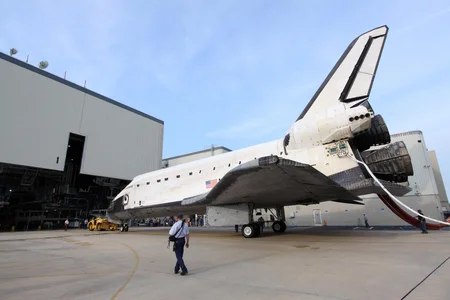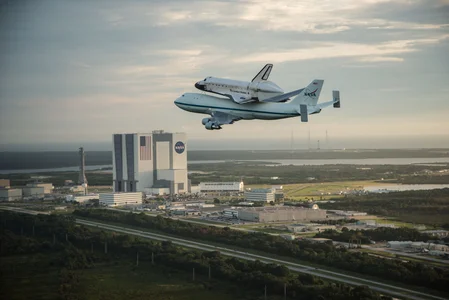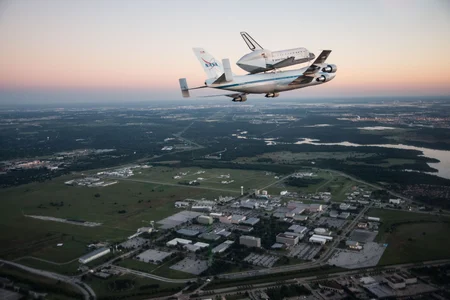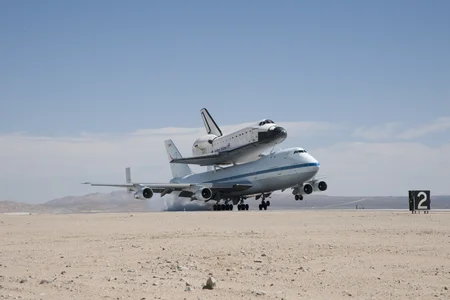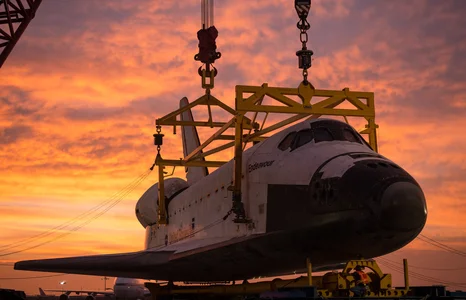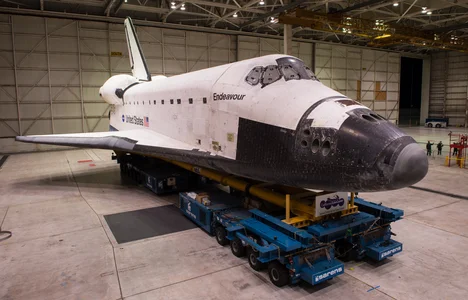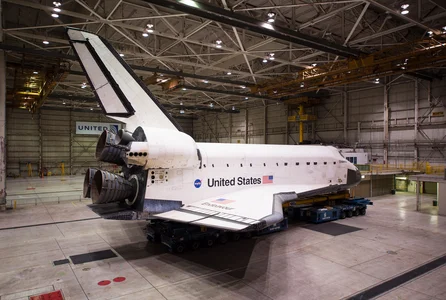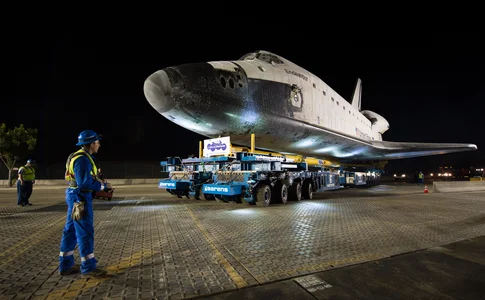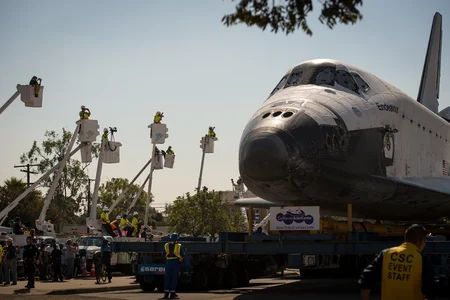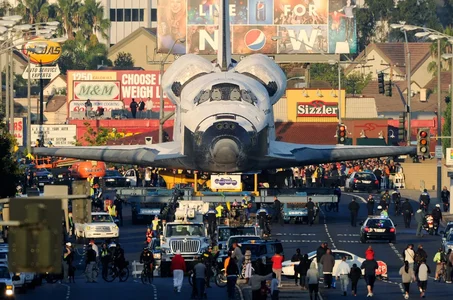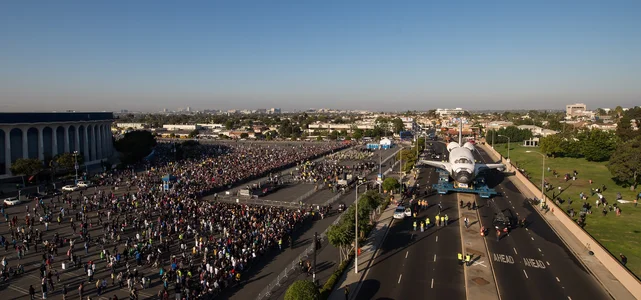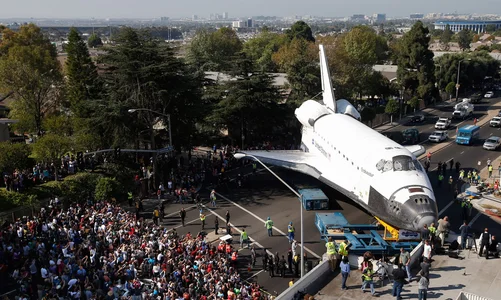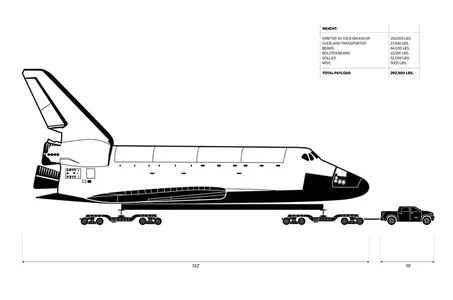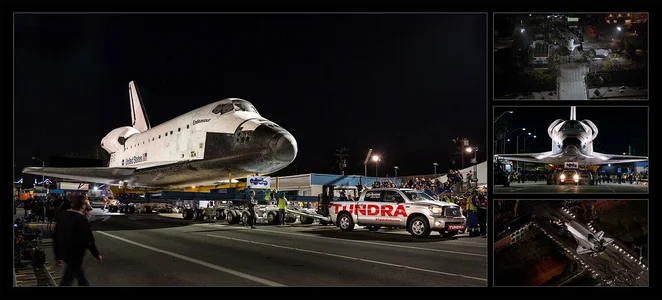The Space Transportation System (STS) was NASA's fourth manned spaceflight program and the world's first successful reusable manned spacecraft. It consisted of a winged orbiter spacecraft coupled to an external fuel tank and two solid rocket boosters, and was capable of carrying up to eight crew members and up to 65,000 lbs of payload in a 60 foot by 15 foot unpressurized cargo bay.
A total of one test and five actual Space Shuttle orbiters were built by Rockwell International between 1979 and 1991:
- Enterprise (OV-101)
- Columbia> (OV-102)
- Challenger (OV-099)
- Discovery (OV-103)
- Atlantis (OV-104)
- Endeavour (OV-105)
Enterprise
Space Shuttle Enterprise (OV-101) was delivered to the Intrepid Sea-Air Museum on 23 April 2012.
Retirement
Enterprise was delivered to the Intrepid Sea-Air Museum on 23 April 2012.
Unlike the "real" Space Shuttles, Enterprise did not begin her final journey in Florida; she had previously been delivered to the Smithsonian Institution's storage hangar at Washington Dulles International Airport in 1985 for display at the planned Udvar-Hazy Center. A NASA engineering team visited Enterprise's display in early 2010 and confirmed that she was structurally sound and could safely be flown on the Shuttle Carrier Aircraft. She was transported "back to back" with Discovery, with the Shuttle Carrier Aircraft remaining at Dulles after unloading Discovery in order to load Enterprise approximately a week later.
After being unloaded at JKF International Airport, Enterprise was placed on a flatbed trailer and stored at Hangar 12, then placed on a barge and shipped down the Hudson River to the Intrepid.
- Sources
- NASA. (2 May 2012). Enterprise Over New York.
- NASA. (7 June 2012). Enterprise Moves to Intrepid.
- NASA. (19 July 2012). Enterprise Joins New York's Attractions.
- Intrepid Sea, Air, and Space Museum. Space Shuttle Pavilion.
Columbia
Space Shuttle Columbia (OV-102) was the first spaceworthy orbiter built and flown. Columbia's maiden flight was STS-1 on 12-14 April 1981, and her final flight was STS-107 on 16 January - 1 February 2003.
Challenger
Space Shuttle Challenger (OV-099) was originally built as a structural test article (STA-099) for ground testing of the Shuttle design. However, it was determined that upgrading STA-099 into a spaceworthy orbiter would be easier and less expensive than upgrading Enterprise. Challenger's maiden flight was STS-6 on 4-9 April 1983, and her final flight was STS-51-L on 28 January 1986.
Discovery
Space Shuttle Discovery (OV-103) was the third Space Shuttle orbiter. Discovery's maiden flight was STS-41-D on 30 August - 5 September 1984, and her final flight was STS-133 on 24 February - 9 March 2011.
Retirement
Discovery was delivered to the National Air and Space Museum on 19 April 2012.
Discovery was the first of the retired orbiters to be delivered to its permanent home. For this operation, NASA deployed the Mobile Mate-Demate Device which had been in storage at Kennedy Space Center. This is a portable lifting beam and sling system which enables a Space Shuttle Orbiter to be safely loaded or unloaded from a Shuttle Carrier Aircraft using a pair of mobile cranes. The Mobile Mate-Demate Device was used operationally when Columbia landed at White Sands Space Harbor at the end of STS-3 in 1982, and was also used to unload the prototype Enterprise at the Smithsonian in 1985.
The 2012 delivery of Discovery essentially duplicated the 1985 delivery of Enterprise. After being "safed" and prepared for display, the Orbiter was transported to the Shuttle Landing Facility and the permanent Mate-Demate Device there was used to mount it to the Shuttle Carrier Aircraft (N905NA). It was then unloaded at Washington Dulles International Airport using the Mobile Mate-Demate Device and towed on its own wheels to the adjacent Steven F. Udvar-Hazy Center.
- Sources
- NASA. (16 March 2011). Retirement a New Beginning for Discovery
- NASA. (19 April 2012). Space Shuttle Discovery Readied for Demate
- NASA. (19 April 202). Space Shuttle Discovery Arrives at Udvar-Hazy
Atlantis
Space Shuttle Atlantis (OV-104) was the last of the original batch of orbiters. Atlantis' maiden flight was STS-51-J on 3-7 Occtober 1985, and her final flight was STS-135 on 8-21 July 2011. This was the final flight of the Shuttle program.
Retirement
Atlantis was delivered to the Kennedy Space Center Visitor Complex on 2 November 2012.
Atlantis was the last retired orbiter to be delivered to its permanent home. While moving Atlantis to the Kennedy Space Center Visitor Complex was obviously the easiest of the Orbiter transports, it was by no means a "freebie". During their operational career, the Orbiters were regularly moved between the Shuttle Landing Facility, the Orbiter Processing Facility, and the Vehicle Assembly Building. While the Orbiters were of course regularly moved between the Shuttle Landing Facility, the Orbiter Processing Facility, the Vehicle Assembly Building, and Launch Complex 39, throughout their operational career, the Visitor Complex is actually four miles away at the other end of the Space Center.
Moreover, the sheer size of the Orbiter meant that she could not simply be towed directly to the Visitor Complex. Instead, she was loaded onto the Orbiter Transport System, a massive 76-wheeled vehicle which was originally built by the Air Force to transport Orbiters around Vandenburg Air Force Base. NASA took the vehicle over over after the Air Force decided to scrap its plans to launch Space Shuttle missions from Vandenburg and regularly used it to move loaded Orbiters from the Processing Facility to the Vehicle Assembly Building. Although capable of moving at up to 5 MPH with an Orbiter on board, the OTS maintained a cautious 2 MPH as it wound its way along a meticulously planned ten-mile route to the permanent exhibit location.
(The OTS has since been purchased by SpaceX and modified to carry Falcon 9 rockets.)
- Sources
- NASA. (4 December 2011). NASA to Enhance Shuttle Story at Kennedy with Atlantis
- NASA. (2 October 2012). Atlantis' Payload Bay Doors Closed for Final Time
- NASA. (12 April 2013). Shuttle Stack Construction Marks Latest Milestone
Endeavour
Space Shuttle Endeavour (OV-105) was the final orbiter built, constructed from structural spare parts as a replacement for Challenger. Endeavour's maiden flight was STS-49 on 7-16 May 1992, and her final flight was STS-134 on 16 May - 1 June 2011.
Retirement
Endeavour was delivered to the California Science Center on 23 September 2012.
For Endeavour's delivery to the California Science Center in Los Angeles, NASA broke out another piece of vintage equipment which had not been used in decades: the Overland Transporter strongback frame which Rockwell International had constructed to deliver all six shuttle orbiters from its factory in Palmdale to the NASA Dryden Flight Research Center at Edwards Air Force Base. The Overland Transporter was combined with two four-axle and two six-axle Kamag K24 self-propelled modular trailers (SPMTs). The computer-controlled omnidirectional steering capability of the SPMTs (every axle is independently powered and independently steerable 270 degrees) was critical to navigating the massive spacecraft through the densely built up urban environment.
Endeavour was safed and prepped for display at Kennedy, then mated to the Shuttle Carrier Aircraft and flown to Los Angeles International Airport (LAX) with stops at Ellington Field (EFD), Biggs Army Air Field (BIF), and Edwards Air Force Base (EDW). This was the last Shuttle Carrier Aircraft ferry flight, making tribute flyovers all along the route. These flyovers included the Stennis Space Center, the Michoud Assembly Facility, the Johnson Space Center, the White Sands Missile Range, the Rocketdyne headquarters in Palmdale and finally the Los Angeles area.
She was then de-mated using the Mobile MDD, attached to the Overland Transporter frame, and temporarily stored in one of United Airlines' hangars at Los Angeles International Airport. Finally, she was driven approximately 16 miles through Inglewood and Los Angeles to the Science Center. The route was surveyed in advance using 3D laser scanning and digital modeling, and city workers cleared the way by cutting back trees and taking down utility lines, street lights, and road signs in advance of the Orbiter's path and then putting them back up in her wake.
Toyota's participation in the movement of Endeavour was originally a advertising publicity stunt in which a 2012 Tundra pickup truck would be used to tow the Orbiter for the last quarter mile. However, it was subsequently determined that the ~650,000 pound combined weight of the orbiter and SPMTs was too much to safely cross the Manchester Boulevard Bridge. As a result, the Toyota towing stunt was revised to actually handle this step of the journey.
- Sources
- NASA. (22 August 2012). Endeavour Closer to New Mission of Inspiration.
- Pearlman, Robert Z. (19 September 2012). Space Shuttle Endeavour Departs Florida on Final Ferry Flight. Space.com
- NASA. (21 September 2012). Endeavour Flyovers Draw Excited Fans
- NASA. (21 September 2012). Space Shuttle Endeavour Comes Home to Los Angeles
- NASA. (15 October 2012). Shuttle Endeavour Arrives at CSC After 2-Day Trip Through Los Angeles
- NASA. (24 April 2013). Space Shuttle Overland Transporter Strongback
- David Evans and Associates. Space Shuttle Endeavour Route and Conflict Mapping
- Practical Engineering. (18 October 2022). Endeavour's Wild Journey Through the Streets of Los Angeles.
- Butler. Mission To California: Unconventional Building Requires Unconventional Flexibility.
- NineLives Group. Tundra Endeavour Project.


